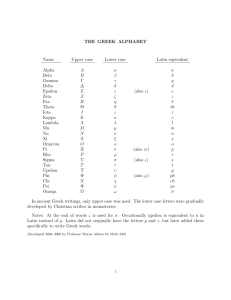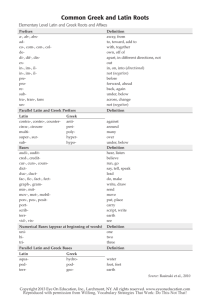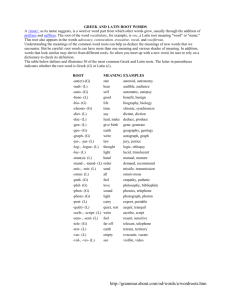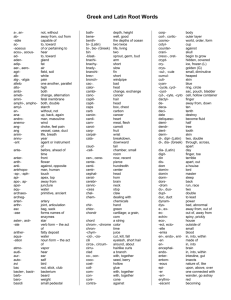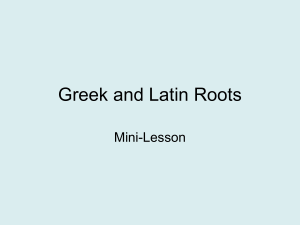teaching english medical neologisms
advertisement
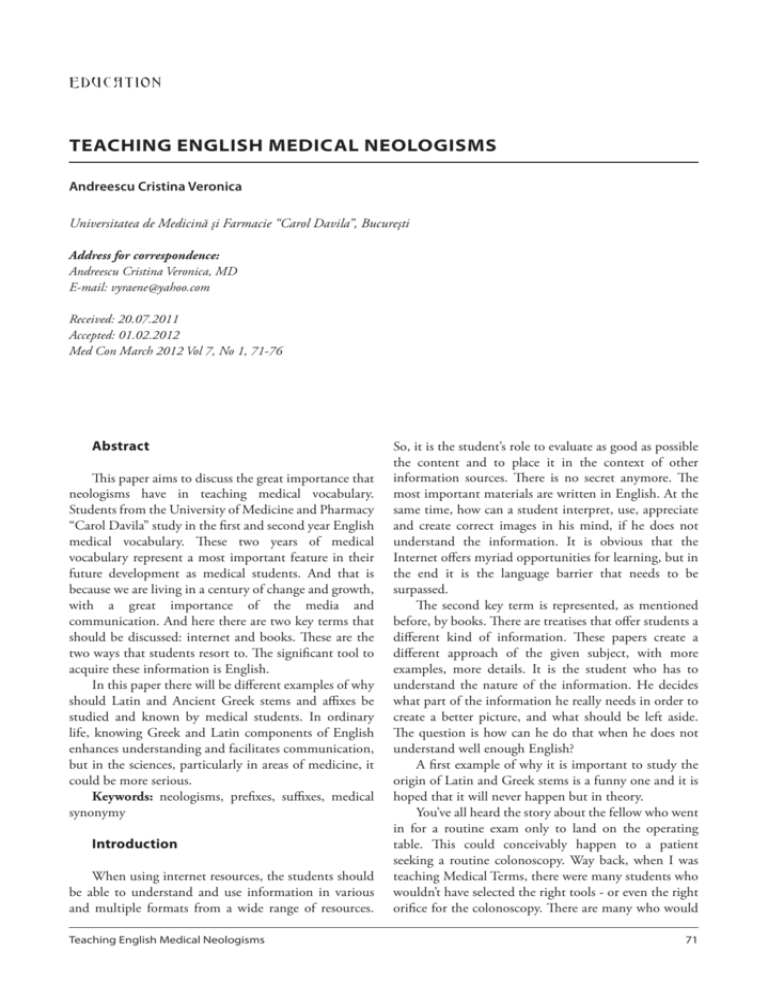
EDucATIOn Teaching english Medical neologisMs Andreescu Cristina Veronica Universitatea de Medicină şi Farmacie “Carol Davila”, Bucureşti Address for correspondence: Andreescu Cristina Veronica, MD E-mail: vyraene@yahoo.com Received: 20.07.2011 Accepted: 01.02.2012 Med Con March 2012 Vol 7, No 1, 71-76 Abstract This paper aims to discuss the great importance that neologisms have in teaching medical vocabulary. Students from the University of Medicine and Pharmacy “Carol Davila” study in the first and second year English medical vocabulary. These two years of medical vocabulary represent a most important feature in their future development as medical students. And that is because we are living in a century of change and growth, with a great importance of the media and communication. And here there are two key terms that should be discussed: internet and books. These are the two ways that students resort to. The significant tool to acquire these information is English. In this paper there will be different examples of why should Latin and Ancient Greek stems and affixes be studied and known by medical students. In ordinary life, knowing Greek and Latin components of English enhances understanding and facilitates communication, but in the sciences, particularly in areas of medicine, it could be more serious. Keywords: neologisms, prefixes, suffixes, medical synonymy Introduction When using internet resources, the students should be able to understand and use information in various and multiple formats from a wide range of resources. Teaching English Medical Neologisms So, it is the student’s role to evaluate as good as possible the content and to place it in the context of other information sources. There is no secret anymore. The most important materials are written in English. At the same time, how can a student interpret, use, appreciate and create correct images in his mind, if he does not understand the information. It is obvious that the Internet offers myriad opportunities for learning, but in the end it is the language barrier that needs to be surpassed. The second key term is represented, as mentioned before, by books. There are treatises that offer students a different kind of information. These papers create a different approach of the given subject, with more examples, more details. It is the student who has to understand the nature of the information. He decides what part of the information he really needs in order to create a better picture, and what should be left aside. The question is how can he do that when he does not understand well enough English? A first example of why it is important to study the origin of Latin and Greek stems is a funny one and it is hoped that it will never happen but in theory. You’ve all heard the story about the fellow who went in for a routine exam only to land on the operating table. This could conceivably happen to a patient seeking a routine colonoscopy. Way back, when I was teaching Medical Terms, there were many students who wouldn’t have selected the right tools - or even the right orifice for the colonoscopy. There are many who would 71 EDucATIOn have gone straight for a woman’s reproductive organs, searching for growths to cut away, mistaking not only the colon for the vagina, but an examination for a cutting procedure. The confusion went the other way as well, with students mistaking a colposcopy (examination of the cervix and vagina) for a colectomy (the removal of the large bowel). Types of neologisms According to the Romanian dictionary, neologisms or neology is a word newly introduced into a language, especially as a means of enhancing literary style [1]. The new word introduced in a language is seen as a means to strengthen the literary style. Longman Dictionary of Contemporary English provides the following definition: ”a new word or expression, or a word used with a new meaning” [2]. An interesting thing is that the online version of the dictionary comes with a at least interesting supplement, giving a synonym, not entirely justified, that of coinage. The noun coinage comes from the verb to coin, which in English means to invent a new word or phrase, especially if the word has great grip on public speaking that language. Webster’s Encyclopedia Unabridged Dictionary of the English Language offers a similar definition: “a new word, usage, or phrase” [3], reminiscent of a synonym for the term in question, namely neology. The word neology appears also in the online sources [4]. The online version of MerriamWebster Dictionary, the medical subdivision, provides an interesting definition of the word, besides the extremely known one, “a word coined by a psychotic that is meaningless except to the coiner” [5], definition terribly limiting access to such a word and to its understanding. There was much conscious use of neologisms, especially from Greek and Latin, in the Renaissance, partly as a result of a definite critical attitude toward the enrichment of the native English vocabulary. But, it should be added that the practice is not confined to any period. Too often, authors employ neologisms in a failing effort to give their style an atmosphere of freshness or erudition (sometimes reaching the limits of pedantry), but the variety, flexibility, and resourcefulness of the modern English vocabulary are partly the cumulative result of the successful use of neologisms. At the same time, there are a vast number of neologisms employed by individual authors or by stylistic “schools” (like the case of euphuism or gongorism), which have not gained permanent foothold in the vocabulary. The Romanian dictionary provides the definitions for two terms “EUPHUÍSM mannered, precious language which was fashionable in England, in 72 MEDICAL CONNECTIONS • NUMBER 1 (25) • MARCH 2012 the Elizabethan times” [1] and “GONGORÍSM formalist and hermetic literary manner, appeared in Spain at the end of the XVI century, characterized by abuse of pompous images and turns of phrases, by preciosity and affect; cultism” [1]. In the end, the neologism can fall into two categories: stable and unstable. A stable neologism is a word which has already gained some recognizable and likely somewhat lasting foothold in usage, at least in the circles familiar with the subject domain related to the word (e.g., words which have recently been added to print dictionaries, including popular slang dictionaries). Unstable neologisms are words which are being proposed by individuals or are being used in a very small subculture. Protologism [Greek protos, first + Greek logos, word; cf. prototype, neologism] is a newly created word which has not yet gained any wide acceptance. It is a prototype or a hypothetical projection of a new lexical unit before it may become current in writing or speech. The word ”protologism” proposed here and now is itself an example of a protologism and was invented by Mikhail Epstein [6]. In contrast to protologisms, neologisms are words that have already been in public usage by authors other than their inventors. As soon as a protologism finds its way into newspapers and websites, journals and books, it becomes a neologism. Diffused Neologisms are those newly coined words which have already reached a significant audience (such as those perhaps used publicly by prominent figures in the popular culture or which have entered a significant subculture (e.g., jargon or lingo), but which have not gained full mainstream acceptance (at least in one of their uses). A buzzword (also known as a fashion word) is an idiom, often a neologism, commonly used in technical, administrative, and sometimes political environments. Buzzwords appear ubiquitously but their actual meanings often remain unclear. Buzzwords are typically intended to create the impression of knowledge for a wide audience. They tend to be non-controversial and universal. Buzzwords differ from jargon in that they have the function of impressing or of obscuring meaning, while jargon (ideally) has a well-defined technical meaning, if only to specialists. However, the hype surrounding new technologies often turns technical terms into buzzwords. A buzzword may or may not appear in a dictionary, and if it does, its meaning as a buzzword may not match the conventional definition. An example could be paradigm shift. Andreescu et al MEDICAL CONNECTIONS • NUMBER 1 (25) • MARCH 2012 A small fragment of a medical text The students from the University of Medicine and Pharmacy Carol Davila study in the first two years a series of medical texts that will help them learn the adequate terminology as well as understand better the need to learn the English term correctly. At first sight, it may seem that the part with the correct English term is a little bit exaggerated. But, in fact, a problem that should be dealt with regards the students’ incapacity to draw a specific line between the Romanian terms and the English ones. In a more than simplistic ways, for the Romanian medical student, the English word should be, more or less close to the English term (they overlook the problems regarding spelling). Here is an example of a text studied by medical students. The most significant part of the lesson is the assimilation of the terminology. The text does not contain any difficult terms and it surely is not worthy to be part of a treatise. It is just an easy text which is meant to better strengthen the medical vocabulary. Maybe it was a little hasty to state that it was an easy text, because the deeper layer shows a different kind of problem: the problem of the word’s etymology. The words borrowed from Latin and Greek require a different approach and need to be studied carefully, because of their spelling and pronunciation aspects. Air sacs or Alveoli = The air cells of the lungs which exchange oxygen and carbon dioxide with the blood. Bronchial Tubes = The two branches of the trachea which go to the lungs. Diaphragm = A large muscle that separates the abdomen from the chest cavity. Epiglottis = A cartilage that covers the windpipe (trachea) when food is swallowed to prevent choking. Larynx = The enlarged part of the trachea often called the voice box. Medulla = The part of the brain that controls the breathing. Pharynx = The passageway at the back of the mouth that allows air to pass from the nasal cavity to the voice box and from the mouth to the esophagus. Trachea = The windpipe which divides into two branches at its lower ends.” These eight words which are vital in teaching the respiratory system, must be analyzed, as their origins can speak volumes about them. Let us take each one and briefly outline its great importance in the future study of other medical neologisms. Alveolus comes from Latin and it is equivalent to alve (us) concave vessel + -olus, var. of –ulus, -ule. The word alveolus has the plural according to the Latin rule Teaching English Medical Neologisms EDucATIOn of -us changing in –i (singular alveolus, plural alveoli). Attention should be paid to the pronunciation of the –i in English which is marked by the sound [ai]. Bronchus, a Latin as well as Greek word comes from the word bronchia, the end of trachea. It has the same way of creating the plural form. It is necessary to add that the spelling and pronunciation of this word are essential, as there are more than 64 words that are formed, starting from the combining form of bronchus, i.e. broncho-: bronchial, bronchus, bronchiole, bronchopneumonia, bronchoscope, bronchitis, bronchogenic, bronchospasm, etc. Besides the changes occurring from one language into another, the presence of the letter c between n and h, should be highlighted, because it makes the difference between a language connoisseur and a beginner. Diaphragm is a term coming from Greek. It is equivalent to dia- (through) + phragma (wall). Dia- is a prefix occurring in loan words from Greek (dia“through) + gignoskein “to learn” diagnosis) and used, in the formation of compound words to mean “passing through” (diathermy the production of heat in body tissues by electric currents, for therapeutic purposes, dia - through, terme - heat), [1] “thoroughly”, “going apart” (dialysis, the separation of large molecules, as proteins, from small molecules and ions in a solution by allowing the latter to pass through a semipermeable membrane, dia- through, lysis - separation) [1]. Epiglottis, with the plural epiglottises or epiglottides is a word borrowed from Greek. Epi- is a prefix occurring in loan words from Greek, where it meant “upon”, “on”, “over”, “near”, “at”, “before”, “after”; on this model it was used in the formation of new compound words (epicardium epi- over, kardia –heart) [1]. The word larynx comes from Greek and it meant the throat, the gullet. A problem related to the term larynx is the plural forming; it has two forms of plural larynges and larynxes. Medulla is an example of term taken from Latin (where it means either marrow or essence), [7] but which has two kinds of plurals: English and a Latin one. The English plural is medullas, while the Latin plural is medullae, following the Latin rule of -a turning into –ae (attention should be paid to pronunciation: in Latin is heard as [e], in English is heard as [i]. Pharynx with the plural pharynges or pharynxes comes from the Greek word phárynx, which means throat, akin to pháranx, which meams gulf, chasm. Trachea from the Greek tracheia, is the short for arteria tracheia, rough artery, i.e. windpipe. The plural is tracheae, applying the same rule like in the case of the medical term medulla. 73 EDucATIOn Efficient Greek and Latin prefixes and suffixes Latin was the language spoken by the ancient Romans. As the Romans conquered most of Europe, the Latin language spread throughout the region. Over time, the Latin spoken in different areas developed into separate languages, including Italian, French, Spanish, and Portuguese. These languages are considered sisters, as they all descended from Latin, their mother language. In 1066 England was conquered by William, duke of Normandy, which is in northern France. For several hundred years after the Norman invasion, French was the language of court and polite society in England. It was during this period that many French words were borrowed into English. Linguists estimate that some 60% of our common everyday vocabulary today comes from French. Thus many Latin words came into English indirectly through French. Many Latin words came into English directly, though, too. Monks from Rome brought religious vocabulary as well as Christianity to England beginning in the 6th century. From the Middle Ages onward many scientific, scholarly, and legal terms were borrowed from Latin. During the 17th and 18th centuries, dictionary writers and grammarians generally felt that English was an imperfect language whereas Latin was perfect. In order to improve the language, they deliberately made up a lot of English words from Latin words. For example, fraternity, from Latin fraternitas, was thought to be better than the native English word brotherhood. Just a little study of terminology could point out that roots rarely exist alone. They usually precede suffixes. The same is true of Greek and Latin, even if, when borrowing, English sometimes drops the suffix. Thus, the word cell in English is really the Latin cella, from which it has been dropped the “a” suffix [8]. Not only do almost all English words contain roots plus suffixes, but suffixes can’t stand alone. A suffix does not have meaning on its own, but needs to be connected to the root. A suffix is an inseparable form that cannot be used alone but that carries an indication of quality, action, or relation. When added to a combining form, it makes a complete word and will determine whether the word is a noun, adjective, verb, or adverb. This is different from a compound word which, in loose English usage, is usually thought of as just another case of root plus suffix. Sometimes two Greek or Latin words are put together to form a compound word. Often they are thought as suffixes when they are not, technically, although they may be thought of as end forms. 74 MEDICAL CONNECTIONS • NUMBER 1 (25) • MARCH 2012 Greek or Greek-based words make use of prefixes even more heavily than Latin or Latin-based words. The use of two prefixes within one word is not uncommon; prefixes in the medial position, too, are not a rare occurrence. The prefix “a/ an” is all-important. Also, it is vital to determine the Latin equivalent for as many Greek prefixes as possible. For some, this is pretty straightforward: the Latin “circum” is obviously the equivalent for the Greek “peri.” For a number of Greek prefixes, however, -such as “kata,” “meta,” and “pros”- there is no single Latin equivalent. A few Greek prefixes are complex with regard to their meaning: this is especially true of “meta,” which can have the meanings “behind” or “beyond” (as in “metacarpal” G. meta, after, + L. carpus, wrist [7] and “metaphysics” G. meta, after, + physis, growth [7] ”metatarsal” G. meta, after, + L. tarsus, ankle [7]), “among” or “change” (as in “metamorphosis”). Among the noun suffixes, “sis,” “osis,” “ia,” “sia,” and “oma” are especially important. Greek has its diminutive suffixes. The adjectival suffixes “ticos,” “icos,” and “acos,” often have a Latin-derived suffix (usually “al”) added on to them. It is essential to note, in particular the handy “itis” suffix (it is the equivalent of ”ită” in Romanian, used in many examples of inflammation: pharyngitis, laryngitis, appendicitis, sinusitis. Also much used is “oid.” The latter is, in fact, not a true suffix derived as it is from the noun “eidos (form, shape, likeness); it can occupy a medial position within a word, as in “thyroidscopy.” Here are some examples of Greek derived words: orthodontist: orthos (“straight”); odous, odontos (“tooth”); ist (noun suffix denoting agent) - “a person who straightens teeth” gangliectomy: ganglion (“cyst”, “swelling”); ek (prefix meaning “out of ”); tome (“cutting”); y (Anglicized form of the noun suffix “ia” denoting process or action)- “the cutting out of a cyst”. gastroenterostomy: gaster, gastros (“stomach”); enteron (“that within,” “intestine”); stoma (“mouth,” “opening”); y (same suffix as in preceding word)- “the making of an opening between the stomach and the intestine” hemiopia-hemi (prefix meaning “half ”); op (“to see,” “sight”--a root word); ia (noun suffix here denoting condition)- “a half-seeing” Latin prefixes: inter- between interwine, intercellular, intervertebral non- no nonessential, nonmetallic, nonsensitive post- after postcrisis, postnatal, postoperative pre- before preconceive, preoperative, prenatal Andreescu et al MEDICAL CONNECTIONS • NUMBER 1 (25) • MARCH 2012 Latin suffixes: -ation forms nouns from verbs: examine – examination; cicatrize –cicatrisation; humidify – humidification -fy, -ify forms verbs purify, humidify, gasify -ty, -ity forms nouns from adjectives: certainty, cruelty, fatality Greek roots: -anthrop- -anthropos- man misanthrope, misanthropos rom misein to hate” +anthropos (man) [9] anthropoid anthropos (man) + eidos, (shape), anthropomorphic anthropomorphus”with human shape” from anthropos (man) +morphe ”shape” [10] -chron- time anachronism, chronic, chronicle -dem- people endemic, pandemic -pedo-, -ped- child, pediatrician Greek prefixes: a-, an- without anaerobic, atypical bio-, bi- life, living organism biology, biophysics, biopsy hyper- excessive, excessively hyperactive, hypersensitive, hyperacidity micro- small microorganism, microscope Synonymy in the medical language The discussion about the medical synonymy reveals another aspect; even the word synonymy comes from Greek [“syn” (with, together) and “onoma / onyma” (name)]. Because scientific language draws heavily both on Latin and Greek, the potential for synonymy is very great. For instance, a very good example is the skeleton, where there are many examples of synonymy. English skull = Greek cranium, plural crania English rump bone = Greek coccyx, plural coccyges English collar bone = Latin clavicle English upper arm bone = Greek humerus, plural humeri Teaching English Medical Neologisms EDucATIOn English knee cap = Latin patella, plural patellae English shinbone = Latin tibia English splinter bone = Latin fibula English heel bone = Latin calcaneum, plural calcanea or calcaneus, plural calcanei. And the examples could go on. There are several different types of synonymy. The most useful distinction can be made between literal synonymy, whereby two (or more) words bear the same literal meaning (but may be used with a different reference), and functional synonymy, whereby two (or more) words are used with the same reference (but may not have the same literal meaning). Thus the Latinderived “subcutaneous” and the Greek-derived “hypodermic” have the same literal meaning (“below the skin”), but they cannot be used interchangeably. On the other hand, “Caesarian section” (reflecting the fallacious tradition that Julius Caesar, the great dictator and founder of the first Roman imperial dynasty, was delivered from his mother’s womb by means of surgical intervention) and the Greek-derived “hysterotocotomy” do not have the same literal meaning but are functionally equivalent—the latter term is simply the more eruditesounding and more likely to be used in a scientific journal. Another important aspect regards the shortening. Shortened forms are a great convenience and their use is perfectly appropriate in many cases. However, a shortened form could sometimes be misleading. Thus “megastria” is an unacceptable shortened form of “megagastria” (enlargement of the stomach), because it suggests a derivation from “mega” and “astron” or “aster” (star) rather than from “mega” and “gaster” (stomach). When studying medical terminology, there are also examples of misnomers, like 1 for (anaemia), 7 (nostology), 8 (orthopaedics), 15 (autopsy), and 18 (hysteria). Fortunately, some of these have fallen or are falling out of use: e.g. “nostology” as a synonym for “gerontology”; this term, apparently American-coined, probably reflects the notion that old age is like a return to childhood (interestingly, in Dutch the popular word for “senile” is still “kinds”-”childlike”). “Hysteria” is no longer an acceptable diagnostic psychiatric term; it probably reflects the ancient notion-going back, in fact, to Greco-Roman antiquity-that women’s maladies and diseases, both physical and psychological, are related to the womb; in Greco-Roman medical writings an unstable or “wandering” womb is often regarded as the chief cause of a woman’s health problems. What happens to the words that draw on more than one source-language? These are hybrid words, and again the word comes from the Greek “hybris” (means extreme 75 EDucATIOn haughtiness, pride or arrogance, overrating the character’s freedom forces and confrontation with destiny (considered as source of tragic in ancient drama) [1]. Could this be a serious linguistic violation? Since scientific language draws on both Latin and Greek, the potential for the creation of hybrid words is very great, even greater when one considers the use of non-Latin and non-Greek word-elements as well. Sometimes hybrid words are unavoidable: thus an adjective such as “thalamocortical,” denoting a relationship between the cortical layer of the brain (Latin: “cortex”-bark, outer layer) and the thalamus of the brainstem (Greek: “thalamos”-chamber) is unavoidable. Conclusions It is very difficult to end a paper on a subject that includes Latin and Greek, and their major influence. It would be wrong to consider that this subject can be ever touched completely, as long as the medical scientific language evolves together with the medical research. The paper tried briefly to mention the most important aspects, but at the same time, trying to emphasize the wide range of terminology employed by the medical students. It is essential for students to know which are the exact roots, prefixes and suffixes from Latin and Greek, as they will have to study the plural forms (which are 76 MEDICAL CONNECTIONS • NUMBER 1 (25) • MARCH 2012 created after the rules in Latin and Greek) and they will have to understand the meaning of compound words (making the difference between para- and peri-, for example). References 1. ***Dicţionarul Explicativ al Limbii Române, Ediţia a II-a. Editura Univers Enciclopedic, Bucureşti, 1996, p. 300,343,352,429,467, 686 2. *** Longman Dictionary of Contemporary English, Longman Dictionaries, England, 1995, p. 949 3. *** Webster’s Encyclopedic Unabridged Dictionary of the English language, Grammercy Books, New York, 1996, p. 958 4. http://www.thefreedictionary.com/neology 5. http://www.merriam-webster.com/medical/ neologism 6. http://en.wikipedia.org/wiki/Mikhail_Epstein 7. F. Peter Lisowski, Charles E. Oxnard, Anatomical terms and their derivations, University of Western Australia, Australia, 2007, p. 24,32,106 8. http://www.merriam-webster.com/dictionary/cell 9. h t t p : / / w w w . e t y m o n l i n e . c o m / i n d e x . php?term=misanthrope 10. http://www.etymonline.com/index.php?allowed_in_ frame=0&search=anthropomorphic&searchmode=n one Andreescu et al

